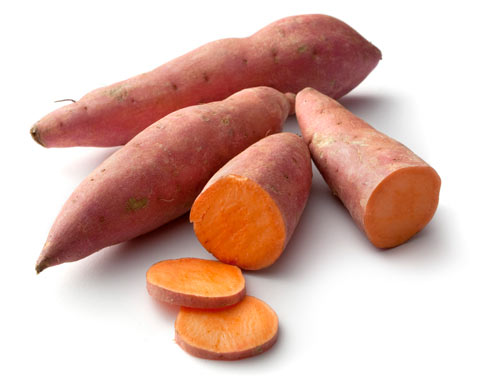Surprising Health Benefits of Potatoes and Sweet Potatoes

Fun Facts:
Got acne? Try washing with potato juice to clear up blemishes! Other home remedies including adding potatoes to a meal to prevent indigestion. (i.1)
Though labeled as such, sweet potatoes are not yams, which are much starchier and not as sweet. (i.1)
People enjoy eating potatoes (sweet and white) so much they are a staple food worldwide. Nevertheless, with obesity on the rise, starchy potatoes have gotten a bad rap as just empty calories that contribute to weight gain and associated diseases (including cancer). Now researchers are re-evaluating that reputation in light of studies that show both potatoes and sweet potatoes have anti-cancer properties. (i.42, 86)
Though the potato and sweet potato have similar names and shapes, these tuberous vegetables are actually from completely different plant families. The potato (Solanum tuberosum) is part of the Solanaceae plant family along with other food species such as tomato, eggplant, and chili pepper. First grown in the Peruvian Andes by the Incas as early as 3000 years ago, the potato is a tuber that eventually spread throughout the world. Although there are over 500 potato varieties worldwide, the typical grocery store in the United States usually carries less than 10 of them. (i.1, 87, 88)
The sweet potato (Ipomoea batatas) is part of the Convolvulaceae plant family and related to the morning glory flower. Brought back to Europe by Columbus from the island of St. Thomas, sweet potatoes are also native to Peru, where archaeological findings suggest humans may have eaten them over 10,000 years ago. These sweet root vegetables are now primarily grown in India and Asian countries as well as in the United States in North Carolina, South Carolina, and Louisiana. There are about 400 different varieties of sweet potato. (i.1, 89)
Sweet potato greens are popular edibles in Africa and Asia, but North Americans tend to prefer the root. Sweet potato roots are long with tapered ends. They may have dark or light-skins with beige, brown, red, or purple exteriors. The flesh inside sweet potatoes ranges in color from beige to purple, yellow, or orange. In North America, orange sweet potatoes are often confusingly called yams, which are different from the original vegetable yam. (i.89-91)
Aren’t High Glycemic Index Foods Bad for You?
The glycemic index (also referred to as glycemic load) was developed to provide an indicator of carbohydrate quality in food. It reflects the effect of each food on blood sugar levels once consumed. In general, foods with higher glycemic index numbers (70 or over) are associated with increased risk of adult-onset diabetes, while studies suggest that consuming diets with lower glycemic index foods may help with weight loss. (i.86)
However, research indicates that it may be too simplistic to assume all foods with a high glycemic index are bad for you. Species of potato, texture, method of preparation, temperature when eaten, and other foods consumed at the same time all affect the glycemic index of potatoes. (i.42, 86)
For example: (i.86)
- Adding cheddar cheese to potatoes reduced the glycemic index to the point where the meal actually had a low glycemic index.
- Cooled or cold potatoes have significantly lower glycemic index numbers, even when reheated. This effect is enhanced when vinegar is added (as in potato salad).
- Waxy textured and new potatoes have lower glycemic indexes than starchy, mature potatoes.
- Boiled potatoes have a glycemic index below 70.
Additionally, in a clinical study people who ate potatoes felt significantly less hungry in the four hours following the meal (which also included meat) than those who ate rice or pasta. This effect was not only measured by subjective feelings of hunger but by measurement of hormone levels. Those that consumed potato experienced significant increases in ghrelin (a hormone that helps regulate hunger) over all 4 hours after eating, while ghrelin levels began decreasing in the 2nd and 3rd hours for those who ate pasta or rice. Potatoes also only stimulated insulin levels for the first 2 hours, as opposed to the entire 4 hours with pasta and rice. Another 4-week human study demonstrated that extracts from purple potatoes lowered cholesterol levels and suppressed weight gain. (i.86)
Despite having a high glycemic index, when eaten in moderation and not fried the high nutrient content of white and sweet potatoes make them a better carbohydrate choice than refined starches (e.g., non-whole grain pasta). Indeed, the World Health Organization advises that some high glycemic index foods may be good dietary choices because they contain substantial levels of important nutrients, and should not be avoided simply based on a high GI number. (i.86)
Beneficial Cancer-Fighting Nutrients in Potatoes and Sweet Potatoes
Sweet potato leaves, or greens, are rich in polyphenols such as caffeic acids, chlorogenic acid, 3,4,5-tri-O-caffeoylquinic, and quercetin. Lab studies suggest that these substances could play a role in preventing stomach and colon cancer as well as leukemia. Sweet potato leaves also include antioxidant dietary polyphenols such as anthocyanins and phenolic acids, which both lab and animal studies show can kill prostate cancer cells and stop prostate tumors from growing. In a study of elderly people, those who consumed berries high in the same types of anthocyanins had a much lower rate of any kind of cancer. (i.91-94)
Like carrots, sweet potatoes contain retinoic acid, a derivative of vitamin A, which may help kill breast cancer cells in early stages of the disease. The deeper orange a sweet potato is, the more beta-carotene its flesh contains. Purple-flesh varieties contain anthocyanins like cyanidins and peonidins with anti-inflammatory and antioxidant properties that fight the harmful effects of free radicals and heavy metals. (i.86, 95, 96)
In addition, both sweet and non-sweet potatoes contain a number of polyphenols, fiber, and fatty acids that exert antioxidant and detoxifying effects. For example, short chain fatty acids (such as butyrate) and dietary fiber are linked to lower colon cancer risk, and lab studies suggest that glycoalkaloids may be beneficial against cervical, colon, liver, lung, lymphoma, and stomach cancers. Lectins are known to bond to cancer cell membrane receptors and trigger cell death. Other lab research indicates that extracts from Rio Grande Russet and Russet Nugget potatoes (not sweet potatoes) effectively inhibited breast cancer cells. The plethora of beneficial micronutrients and phytochemicals in potatoes and sweet potatoes can help maintain good health and may lower the risk of cancer. (i.1, 86, 96, 97)
|
Potatoes |
Sweet Potato |
Sweet Potato Greens |
|||||||
|---|---|---|---|---|---|---|---|---|---|---|
| Calories | 93 | 90 | 34 | |||||||
| Fiber | 2.20 g | 3.30 g | 1.90 g | |||||||
| Net carbohydrates | 18.95 | 17.41 g | 5.42 g | |||||||
| Flavonoids | ||||||||||
|
Anthocyanins and anthocyanidins |
? | ? | ||||||||
| Vitamins | ||||||||||
| Alpha-tocopherol (form of vitamin E) | 0.04 mg | 0.71 mg | 0.96 mg | |||||||
| Folate | 28.0 mcg | 6.0 mcg | 49.0 mcg | |||||||
| Gamma-tocopherol (form of vitamin E) | — | 0.01 mg | ? | |||||||
| Niacin (vitamin B3) | 1.41 mg | 1.487 mg | 1.003 mg | |||||||
| Pantothenic acid (vitamin B5) | 0.376 mg | 0.884 mg | 0.2 mg | |||||||
| Riboflavin (vitamin B2) | 0.048 mg | 0.106 mg | 0.267 mg | |||||||
| Thiamine (vitamin B1) | 0.064 mg | 0.107 mg | 0.112 mg | |||||||
| Vitamin A | 10.0 IU | 19,218.0 IU | 916.0 IU | |||||||
| Vitamin B6 (pyridoxine) | 0.311 mg | 0.286 mg | 0.16 mg | |||||||
| Vitamin C | 9.6 mg | 19.6 mg | 1.5 mg | |||||||
| Vitamin K | 2.0 mcg | 2.3 mcg | 108.6 mcg | |||||||
| Beneficial Fatty Acids | ||||||||||
| Acetate (short chain fatty acid) | ? | |||||||||
| Butyrate (short chain fatty acid) | ? | |||||||||
| Omega-3 | 0.013 g | 0.0004 g | 0.021 g | |||||||
| Omega-6 | 0.043 g | 0.06 g | 0.113 g | |||||||
| Propionate (short chain fatty acid) | ? | |||||||||
| Minerals | ||||||||||
| Boron | ? | ? | ||||||||
| Calcium | 15.0 mg | 38.0 mg | 24.0 mg | |||||||
| Copper | 0.118 mg | 0.161 mg | 0.033 mg | |||||||
| Iron | 1.08 mg | 0.69 mg | 0.6 mg | |||||||
| Lithium | ? | ? | ||||||||
| Magnesium | 28.0 mg | 27.0 mg | 61.0 mg | |||||||
| Manganese | 0.219 mg | 0.497 mg | 0.229 mg | |||||||
| Phosphorus | 70.0 mg | 54.0 mg | 60.0 mg | |||||||
| Potassium | 535.0 mg | 475.0 mg | 477.0 mg | |||||||
| Selenium | 0.4 mcg | 0.2 mcg | 0.9 mcg | |||||||
| Sulfur | ? | ? | ||||||||
| Zinc | 0.36 mg | 0.32 mg | 0.26 mg | |||||||
| Carotenoids (Tetraterpenes) | ||||||||||
| Alpha-carotene | — | 43.0 mcg | 550.0 mcg | |||||||
| Antheraxanthin | ? | ? | ||||||||
| Beta carotene | 6.0 mcg | 11,509.0 mcg | ? | |||||||
| Lutein and zeaxanthin | 30.0 mcg | — | 2633.0 mcg | |||||||
| Violaxanthin | ? | ? | ||||||||
| Amino Acids | ||||||||||
| Alanine | 0.077 g | 0.11 g | ? | |||||||
| Arginine | 0.115 g | 0.093 g | ? | |||||||
| Aspartic acid | 0.611 g | 0.344 g | ? | |||||||
| Cystine | 0.031 g | 0.016 g | 0.027 g | |||||||
| Glutamic acid | 0.419 g | 0.197 g | ? | |||||||
| Glycine | 0.074 g | 0.091 g | ? | |||||||
| Histidine | 0.054 g | 0.037 g | ? | |||||||
| Isoleucine | 0.101 g | 0.10 g | ? | |||||||
| Leucine | 0.15 g | 0.147 g | ? | |||||||
| Lysine | 0.152 g | 0.099 g | ? | |||||||
| Methionine | 0.039 g | 0.049 g | 0.050 g | |||||||
| Phenylalanine | 0.111 g | 0.120 g | ? | |||||||
| Proline | 0.09 g | 0.089 g | ? | |||||||
| Serine | 0.109 g | 0.104 g | ? | |||||||
| Threonine | 0.091 g | 0.100 g | ? | |||||||
| Tryptophan | 0.039 g | 0.025 g | 0.020 g | |||||||
| Tyrosine | 0.092 g | 0.083 g | ? | |||||||
| Valine | 0.141 g | 0.131 g | ? | |||||||
| Beneficial Phytochemicals | ||||||||||
| Caffeic acid | 3.60 mg | 0.3-2.2 mg | ||||||||
| Catechin and epicatechin | ? | ? | ||||||||
| Chlorogenic acid | 0.35-18.71 mg | 4.6-13.6 mg | ||||||||
| Ferulic acid | ? | ? | ||||||||
| Gallic acid | ? | |||||||||
| Glycoalkaloids (alpha-solanine and alpha-chaconine) | ? | ? | ||||||||
| Kaempferol | 0.05 mg | ? | ? | |||||||
| Lectins | ? | ? | ||||||||
| Lycopene | ? | ? | ||||||||
| Patatin (a protein) | ? | ? | ||||||||
| Quercetin | ? | 20.54 mg | ||||||||
| Rutin | ? | ? | ||||||||
| Vanillic acid | ? | ? | ||||||||
Adding Potatoes and Sweet Potatoes to Your Diet
In general, antioxidants in potatoes are highest in those with the reddest skin and flesh (as opposed to brown skin and white/yellow flesh). Good potatoes are firm with taut skin, and relatively heavy depending on their size. Avoid potatoes with wrinkled, green, or mushy skin. The potato's exterior should not contain blemishes, sprouts, or mold. Don't choose potatoes from a refrigerated supermarket area, since temperatures that are too cold detract from their taste and change their texture, and darkens regular potatoes. Similarly, do not store sweet potatoes or potatoes in a refrigerator; rather, keep them in a cool, dry area with good air circulation. When stored properly, sweet should last for up to 2 weeks and regular potatoes for several weeks. Like potatoes, sweet potatoes are sold in food markets all year long, but are considered in season during November and December. (i.1, 86, 89, 90, 97)
If possible, try to purchase organic potatoes to receive maximum health benefits, since it is safe to consume both their skin and flesh. Wash potatoes thoroughly before cooking (to find and remove any green spots) or peel potato skin off after cooking to avoid eating dye or wax-treated skin. Always try to cook them whole to preserve their nutrient content. If removing potato skin prior to cooking, be sure to cook the potatoes right away. If this is not possible, place them in a bowl and completely immerse them in water to prevent oxidation. (i.1, 102)
Preparing Potatoes and Sweet Potatoes
Studies show that boiling, stir-frying, and steaming sweet potatoes each have unique health benefits. In order to absorb greater amounts of beta-carotene and regulate blood sugar more successfully, boil sweet potatoes. Beta-carotene uptake also increases significantly when sweet potatoes are eaten with at least three to five grams of fat, which converts beta-carotene to a form that is more easily absorbed from the digestive tract. One tasty way to add fat is stir-frying sweet potatoes in oil for five minutes at 200° Fahrenheit to maximize beta-carotene absorption. (i.97)
Steaming sweet potatoes keeps their health benefits along with their flavor. To steam a sweet potato, add two inches of water to a steamer pot and bring it to a boil. Cut potato into 1/2-inch slices and steam for seven minutes. Sweet potatoes can also be served mashed, pureed into soups or served cold in a salad with vinaigrette. The recommended serving size is 1 medium sweet potato, or 114 grams. (i.97)
Choosing to bake or steam regular potatoes also helps retain beneficial nutrients. For example, steamed potato keeps 42% of the polyphenol chlorogenic acid, compared to only 24% if fried. However, people with kidney disorders who need to limit their potassium intake should eat cut up and boiled potatoes, since this significantly reduces potassium content. (i.86, 99)
Growing Potatoes at Home
Potatoes are considered a cool-season crop, but can be planted early, mid, and late-season to provide different harvesting times (65-90 days from planting). Plant a foot apart in 12" deep trenches and cover gradually with loose soil as the potato plants sprout. Keep the soil moist with adequate watering and mulch and avoid nitrogen fertilizer for best results. (i.11)
Warmer climates are best for growing sweet potatoes, but an area receiving four months of warm weather will also suffice. Soil should be fertile, well-drained, and low in nitrogen. Plant certified seed sweet potato plants outside when the soil is at least 60° Fahrenheit and there is no chance of frost. Bury the plant until only the top leaves are visible. Leave at least 6 inches (preferably 12) between plants. (i.103)
Sweet potatoes are one of the easiest organic crops to grow since they attract few pests. If pests like sweet potato whiteflies, weevils, or grubs prove to be a problem, use a neem-based botanical pesticide like Margosan-O or Bioneem. Try to avoid using synthetic pesticides such as thiabendazole, a fungicide typically used on potatoes, because they are potential toxins. (i.102, 104)
Sweet potatoes are ready to harvest between 3 and 4 months after planting, when tubers have reached a length between 4 and 6 inches. If possible, dig up sweet potatoes when the soil is dry and the day is overcast. Dig gently from a few feet away from each potato so as not to harm their roots. After removing sweet potatoes from the ground, cure them by letting them dry in a humid place measuring 85° Fahrenheit (if possible) for seven to ten days. Do not wash them during this time. Afterward, keep potatoes stored in well-ventilated holders like baskets or slatted crates at 60° Fahrenheit, but no lower than 55° Fahrenheit. When stored properly, sweet potatoes should keep for at least 6 months. (i.103)
Be Careful of Toxins in Potatoes and Sweet Potatoes
Sweet potatoes contain cyanide compounds that become thiocyanate when consumed. Thiocyanate is considered a goitrogen — a substance that can inhibit iodine in the body. The thyroid gland needs iodine to produce thyroid hormones, and iodine deficiency can cause serious health problems, including hypothyroidism, decreased fertility and miscarriage, learning disabilities, retardation, and other neurological disorders. Consuming goitrogens can exacerbate iodine deficiency disorders such as hypothyroidism but adequate iodine intake can usually reverse this effect. Using iodized salt is an effective way to counteract iodine deficiency. Potatoes exposed to light can turn green and natural low levels of solanine can reach toxic levels that cannot be removed by cooking. On the other hand, lab experiments show that solanine extracts can kill cancer cells. (i.86, 105, 106)
The green color is actually from the formation of harmless chlorophyll pigment. Though it is not related to the process of solanine production, since chlorophyll and solanine are both made at the same time and in the same area near the potato skin the green color can be used as an indicator of higher solanine levels. You can still use the potato by simply cutting off any green area before cooking. As an extra precaution, you can taste a bit of the raw potato after the green parts are cut off — if there is any bitter taste, throw out the entire potato. (i.102, 106)
They are also high in oxalic acid, which can inhibit calcium availability in the body, and contain proteins that can inhibit pancreatic enzymes needed to break down elastase proteins in meat. However, soaking and cooking potatoes in water helps eliminate these potential problems. (i.58)



